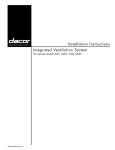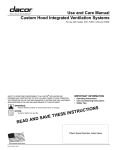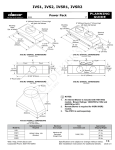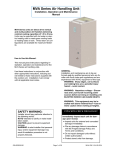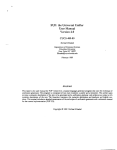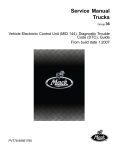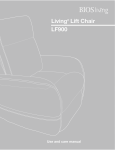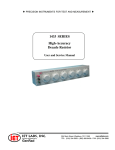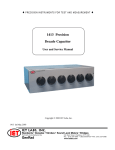Download Dacor IVSR2 Specifications
Transcript
Installation Instructions Power Packs SAVE AND READ THESE INSTRUCTIONS TESTED IN ACCORDANCE WITH THE LATEST EDITION OF ANSI Z21.1 STANDARD FOR HOUSEHOLD COOKING APPLIANCES. CONVENTIONS USED IN THESE INSTRUCTIONS WARNINGS: Must be followed carefully to avoid personal injury. IMPORTANT: Must be followed carefully to avoid damage. NOTES: Contain helpful hints and tips to facilitate the installation. IMPORTANT 1. 2. 3. 4. 5. Before beginning installation, please thoroughly read and become familiar with these instructions. Installation and service must be completed by a qualified installer or service agency. Installer: Please leave these Installation Instructions with the owner. Owner: Please keep these instructions for local electrical inspector’s use and for future reference. Read the accompanying Use & Care Manual prior to operating this appliance. TABLE OF STEPS STEP STEP STEP STEP 1 2 3 4 Planning the installation Electrical connections Installing the Power Pack Verifying proper operation Part No. 65278 Rev. A Page Page Page Page 2-3 4-5 5 5 WARNINGS: TO REDUCE THE RISK OF FIRE, ELECTRIC SHOCK, OR INJURY TO PERSONS, OBSERVE THE FOLLOWING: a) Use this unit only in the manner intended by the manufacturer. If you have questions, contact the manufacturer. b) Before servicing or cleaning unit, switch power off at service panel and lock the service disconnecting means to prevent power from being switched on accidentally. When the service disconnecting means cannot be locked, securely fasten a prominent warning device, such as a tag, to the service panel. Exception: The additional safety instructions do not apply to a ceilingsuspended fan. c) Installation work and eletrical wiring must be done by a qulified person(s) in accordance with all applicable codes and standards, including fire-rated construction. d) Sufficient air is needed for proper combustion and exhasuting of gases through the flue (chimney) of fuel burning euipment to prevent back drafting. Follow the heating equipment manufacturer’s guideline and safety standards such as those published by he national Fire Protection Association (NFPA), and the American Society for Heating, Refrigeration and Air Conditioning Engineers (ASHRAE), and the local code authorities. e) When cutting or drilling into wall or ceiling, do not damage electrical wiring and other hidden utilities. f) Duct fans must always be vented to the outdoors. CAUTION For general ventilating use only. Do not use to exhaust hazardous or explosive materials and vapors. WARNINGS: TO REDUCE THE RISK OF A RANGE TOP GREASE FIRE: a) Never leave surface units unattended at high settings. Boilovers cause smoking and greasy spillovers that may ignite. Heat oils slowly on low or medium settings. b) Always turn hood ON when cooking at high heat or when cooking flaming foods. c) Clean ventilating fans frequently. Grease should not be allowed to accumulate on fan or filter. d) Use proper pan size. Always use cookware appropriate for the size of the surface element. WARNINGS: TO REDUCE THE RISK OF INJURY TO PERSONS IN THE EVENT OF A RANGE TOP GREASE FIRE, OBSERVE THE FOLLOWING:a a) SMOTHER FLAMES with a close-fitting lid, cookie sheet, or metal tray, then turn off the burner. BE CAREFUL TO PREVENT BURNS. If the flames do not go out immediately, EVACUATE AND CALL THE FIRE DEPARTMENT. b) NEVER PICK UP A FLAMING PAN - You may be burned. c) DO NOT USE WATER, including wet dishcloths or towels - a violent steam explosion will result. d) Use an extinguisher ONLY if: 1) You know you have a Class ABC extinguisher, and you already know how to operate it. 2) The fire is small and contained in the area where it started. 3) The fire department is being called. 4) You can fight the fire with your back to an exit. a Based on “Kitchen Fire Safety Tips” published by NFPA. Page 1 CAUTIONS: 1. To reduce the risk of fire and to properly exhaust air the power pack must be exhausted to outside air. Never exhaust into a wall, an attic or a concealed area in the building. This can create a potential hazard. 2. Consult a licensed ventilation contractor or qualified technician for proper installation of exhaust ducting. 3. Locate the cooking area for minimum cross drafts – away from doors and windows, when possible. 4. Ducts must be of adequate size and duct runs should be as short and straight as possible. Where turns are necessary, keep turning radius as large and smooth as possible. 5. The ducting must be air tight. Use a minimum of 2 sheet metal screws at every duct joint. Then, seal the duct joints with a high quality duct tape. 6. Only use ductwork constructed of materials deemed acceptable by state, municipal and local codes. STEP 1 Installation Planning The Dacor Power Packs are designed for installation inside custom hood canopies. Proper installation of the Power Pack is directly related to the custom canopy material construction. Closely follow the warnings concerning the instatlltion of the Power Pack within a combustible and non-combustible hood canopy. A qualified technician must complete the installation of this appliance. Plan the installation so that all minimum clearances are met or exceeded. Dimensions shown provide minimum clearances, unless otherwise noted. WARNINGS: 1. Power packs installed in custom hood canopies, which are contructed of combustible materials, must be installed with the combustible material structure a minimum of 36 inches above the appliance burner surface. 2. Power packs installed in custom hood canopies, which are contructed of non-combustible materials, must be installed with the non-combustible material structure a minimum of 30 inches above the appliance burner surface. 3. Power packs installed in custom hood canopies, which are contructed utilizing the Dacor IHL Stainless Steel Hood Liner, must be installed with the non-combustible material structure a minimum of 30 inches above the appliance burner surface. 4. Follow all instructions regarding minimum safe clearances and installation location. Failure to do so may reault in a fire or safety hazard. 5. To reduce the risk of fire use only metal duct work. NOTE: 1. All dimensional tolerances are + 1/16”, - 0” unless otherwise stated. MEASUREMENTS SPECIFICATIONS Overall Blower Chassis Width Overall Blower Chassis Depth Overall Blower Chassis Height Duct Diameter Electrical Supply Requirements Maximum Duct Length Total Connected Load Blower Rating Approximate Shipping Weight IVS1/IVSR1 - 22 5/8" (575mm) IVS2/IVSR2 - 34 1/2" (876mm) 12 1/4" (311mm) 6" (152mm) IVS1/IVSR1 - 8" (203mm) IVS2/IVSR2 - 2 x 8" (203mm) 120VAC, 60Hz, 15A Maximum 60 Equivalent Straight Feet 1.4kW (12A) IVS1 - 600 CFM IVS2 - 1200 CFM IVS1/IVSR1 - 24 pounds IVS2/IVSR2 - 32 pounds Table 1: IVS Specifications Page 2 STEP 1 (Continued) Installation Planning Equal �� Equal CL CL 6 1/2" (165mm) Equal 6 1/8" (156mm) �� 12 1/4" (311mm) 6 1/2" (165mm) CL Equal 6 1/8" (156mm) CL 12 1/4" (311mm) 22 5/8" (575mm) 34 /12" (876mm) 8" Round collar 8" Round collars Figure 1: IVS1/IVSR1 Overall Dimensions Top View Figure 2: IVS2/IVSR2 Overall Dimensions Top View 10" Round 12" (305mm) 21" (533mm) 8" (203mm) Figure 3: ATD10 Overall Dimensions Isometric View NOTES: 1. Dacor transition model number ATD10 shown in figure 3 is available from your local Dacor dealer. 2. Power Packs are effective when installed with 60 equivalent straight feet of ducting. 3. Power Packs ship with a back-draft damper installed in the collar of the unit. 4. Always install these products with an approved wall or roof cap. 5. Duct performance is achieved by using round duct instead of rectangular. 6. If multiple elbows are used, ensure that there is a minimum of 24 inches of straight duct between any two elbows. 7. Avoid “S” or back to back configurations caused by adjacent elbows. 8. Thermal breaks, such as a short section of non-metallic duct, should be used in areas of extreme cold. 9. Do not use flexible metal duct. 10. Do not use ductwork that is smaller in cross-sectional area than the recommended size duct. 11. Do not rely on duct tape alone to seal duct joints. Use sheet metal screws as required to support the duct. 12. The Power Pack must be removable if service is required. 13. Be certain that the ductwork does not interfere with floor joists or wall studs. 8" (203mm) Round x 2" (51mm) High with back draft damper 8" (203mm) Round x 2" (51mm) High with back draft damper Mounting Holes (typ. all sides) Electrical Access Mounting Holes (typ. all sides) 21 1/4" (540mm) 22 5/8" (575mm) Electrical Access 6" (152mm) 11 1/16" (281mm) 12 1/4" (311mm) 33 1/4" (845mm) 34 1/2" (876mm) Figure 4: IVS1/IVSR1 Overall Dimensions Isometric View 6" (152mm) 11 1/16" (281mm) 12 1/4" (311mm) Figure 5: IVS2/IVSR2 Overall Dimensions Isometric View Page 3 STEP 2 Electrical Connection WARNINGS: 1. Ensure that the power supply is disconnected before proceeding. 2. Verify that the power supply matches the ratings found on the appliance data plate before proceeding. 3. The complete appliance must be properly grounded at all times when electrical power is applied. 4. Do not ground the appliance with the neutral (white) house supply wire. A separate ground wire must be utilized. 5. If aluminum house supply wiring is used, splice the appliance copper wires to the aluminum house wiring with special connectors designed and agency-certified for this purpose. Follow the connector manufacturer’s recommended procedure carefully. Improper connection can result in a fire hazard. 6. Failure to complete electrical connections properly may result in a damaged or non-functional system. Follow the wiring diagrams carefully to ensure a proper installation. It is the owner’s responsibility to ensure that a qualified electrician performs the electrical connection of this appliance. The electrical installation, including minimum supply wire size, must comply with the National Electric Code ANSI/NFPA 70-1990* (or to the latest revision) and local codes and ordinances. *A copy of this standard may be obtained from: National Fire Protection Association 1 Batterymarch Park Quincy, Massachusetts 02269-9101 NOTES: 1. The power pack systems requires a properly grounded, 120 VAC, 60 Hz., 15 Amp electrical service. 2. Maximum full line load is 8 amps. 3. Always use a dedicated circuit. IVS ILB L1 BLK N1 WHT Gnd GRN 120VAC, 60Hz, 15A Supply power from dedicated circuit breaker BLK L2 BLK WHT N2 WHT GRN Gnd GRN IVS L2 N2 Gnd Figure 6: IVS Wiring Diagram IVS L1 BLK N1 WHT Gnd GRN L2 BLK N2 WHT Gnd GRN 120VAC, 60Hz, 15A Supply power from dedicated circuit breaker REMP Figure 8: IVS with REMP Wiring Diagram Page 4 L2 BLK N2 WHT Gnd GRN L1 BLK N1 WHT Gnd GRN L2 BLK N2 WHT Gnd GRN 120VAC, 60Hz, 15A Supply power from dedicated circuit breaker Figure 7: IVS with ILB Wiring Diagram STEP 2 Electrical Connection IVSR ILB BLK L2 BLK L1 WHT BLK N2 WHT N1 WHT Gnd GRN GRN Gnd GRN 120VAC, 60Hz, 15A Supply power from dedicated circuit breaker IVS L1 BLK N1 WHT Gnd GRN 120VAC, 60Hz, 15A Supply power from dedicated circuit breaker L2 BLK N2 WHT Gnd GRN REMP L2 BLK N2 WHT Gnd GRN Figure 10: IVSR with REMP Wiring Diagram Figure 9: IVSR with ILB Wiring Diagram L2 BLK N2 WHT Gnd GRN ILB BLK L2 BLK WHT N2 WHT GRN Gnd GRN IVSR L1 BLK N1 WHT Gnd GRN 120VAC, 60Hz, 15A Supply power from dedicated circuit breaker J-BOX L2 BLK N2 WHT Gnd GRN REMP Figure 11: IVSR with ILB and REMP Wiring Diagram L2 BLK N2 WHT Gnd GRN Step 3 Installing the IVS Mount the IVS using screws (supplied by others) which are installed through the finish trim into the hood liner material. For approximate hole locations refer to figures 4 and 5. Step 4 Verifying Proper Operation 1. 2. 3. Turn on the power supply at the circuit breaker. Turn ventilator control on. Adjust the blower speed and test for affective draw. Turn on the variable control light switch and verify lights operate correctly. NOTE: If the power pack does not operate properly, follow these troubleshooting steps: 1. Verify that power is being supplied to the power pack. 2. Check the electrical connections to ensure that the installation has been completed correctly. 3. Repeat the above tests. 4. If the appliance still does not work, contact an authorized DACOR service company at (800) 772-7778, or at www.dacor.com. Do not attempt to repair the appliance yourself. 5. DACOR is not responsible for service required to correct a faulty installation. Page 5 Web Site: www.dacor.com For a Dealer/Service: (800) 772-7778 Corporate Phone: (800) 793-0093








